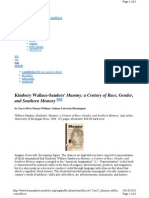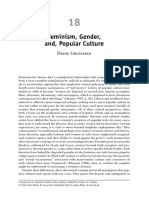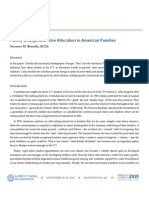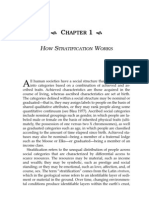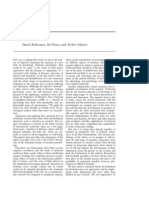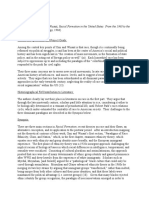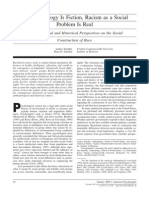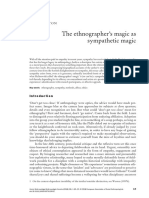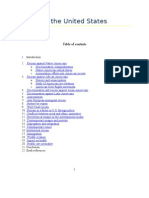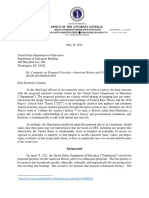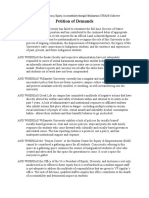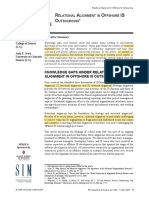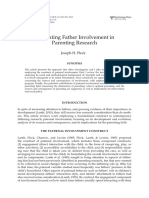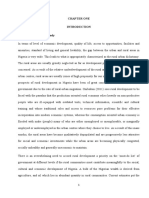Diversity Paradox - Chapter 1
Diversity Paradox - Chapter 1
Uploaded by
Russell Sage FoundationCopyright:
Available Formats
Diversity Paradox - Chapter 1
Diversity Paradox - Chapter 1
Uploaded by
Russell Sage FoundationOriginal Title
Copyright
Available Formats
Share this document
Did you find this document useful?
Is this content inappropriate?
Copyright:
Available Formats
Diversity Paradox - Chapter 1
Diversity Paradox - Chapter 1
Uploaded by
Russell Sage FoundationCopyright:
Available Formats
~ Chapter 1 ~
Introduction: Immigration and the Color Line in America
On November 4, 2008, the United States elected Barack Obama president, elevating an African American to the countrys highest ofce for the rst time. Because Obamas rise illustrates how far the United States has come from the days when blacks were denied the right to vote, when schools and water fountains were segregated, when it was illegal for blacks and whites to marry, and when racial classication was reduced to an absolutist dichotomy of black and white, it is tting to ask: Does Barack Obamas election signify substantial erosion in the countrys long-standing black-white color line? Many scholars and pundits assert that his victory indicates that the country has nally moved beyond race and that the color line that has long divided blacks and whites has largely disappeared. For example, Abigail and Stephan Thernstrom, in an op-ed piece titled Is Race Out of the Race? (Los Angeles Times, March 2, 2008), argued that Obamas enormous appeal among white voters reects a dramatically changed political climate in the United States and that Americans no longer struggle under the burden of race. Other observers proclaimed in a similar vein, that the Civil War had nally ended and that the United States has become a postracial society, no longer bound by racial strictures (see Michael Eric Dyson, Race, Post Race, Los Angeles Times, November 5, 2008, Opinion; Thomas L. Friedman Finishing Our Work, New York Times, November 5, 2008, op-ed; Adam Nagourney, Obama Elected President as Racial Barrier Falls, New York Times, November 5, 2008, op-ed). Undoubtedly, Obamas ascendance to the presidency is a historic event of great importance, one that has broken through barriers many thought would never be breached. In light of W. E. B. Du Boiss famous and pessimistic prophecy over a century ago, The problem of the twentieth-century will be the problem of the color linethe relation of the darker to the lighter races of men (1903/1997, 45), few probably would have thought that shortly after
The Diversity Paradox
the end of the twentieth century the son of a white mother and a black father would become the nations forty-fourth president. Rather, many would have expected Du Boiss racial realism to cause him to anticipate the drop in President Obamas public opinion ratings that occurred by Labor Day of his rst year in ofce (see Adam Nagourney, Looking for Tea Leaves in Obamas Sliding Numbers, New York Times, November 23, 2009). What, then, are we to make of Obamas presidency? What does it signify? Does his election suggest that the color line in the United States is well on its way to being eradicated? Does the decline in Obamas poll ratings hint merely that an exceptionally talented and appealing individualone who just happens to be black and who had the good fortune to follow one of the most unpopular occupants of the White House in historyran a great campaign and was elected president of the United States but is now being judged on his performance according to the standards applied to any president? Given the crushing burden the black-white divide has imposed on African Americans throughout American history, questions about the persistence and disappearance of the color line inspire considerable scholarly interest and carry enormous policy signicance. These questions about the color line are hugely important, too, because of the tectonic shift that took place in immigration in the latter half of the twentieth century and the rst decade of the twenty-rst that has brought millions of newcomers to the country (counting both the foreign-born and their children) who are neither black nor white (Foner and Fredrickson 2004; Bean and Stevens 2003). Almost sixty million such people, largely Latinos and Asians, currently reside here (Bean et al. 2009). On which side of the black-white color line do these new nonwhites fall? If there were convincing reasons that the old black-white divide has largely disappeared, then the question of where the new immigrant groups fall would be largely moot, and the forces driving the color lines dissolution would also probably work to enhance the sociocultural and economic incorporation of the new immigrant groups. Their successful integration would not constitute a significant societal or public policy challenge resulting from substantial discrimination against them. If, on the other hand, the historic black-white color line continues to exist, then the question of which side of the divide Latino and Asian immigrants fall on matters a great deal. In this volume we examine todays color lines through the intermarriage and multiracial experiences of both blacks and the major new immigrant groups. We look at these phenomena from a number of different angles. If our inquiries lead us to conclude that Asian and Latino newcomers are positioned on the black side of the line, then it is likely that their sizable numbers over the past thirty years, together with their continuing high rates of current entry, are probably exacerbating long-standing problems in U.S. race relations (Bean et al. 2009). But if Asians and Hispanics (we use the terms Hispanic and Latino interchangeably here) are falling largely on the white side of the line, it would imply that successful incorporation among the new immigrants is not only
Immigration and the Color Line in America
possible but probably also actually occurring. Given this case, important questions arise as to how the nonwhite diversity brought about by immigration is contributing to the weakening of boundaries between the new immigrants and native whites, and whether Latinos and Asians are involved in these processes in similar ways and to the same degree. Even more important, if growing diversity seems to be loosening the ethnoracial boundaries that have constrained the life chances of new immigrants, is this diversity, along with rising familiarity among native-born Americans of an ever more multicultural country, beginning also to erode the black-white divide? In seeking answers to these questions, we pull together in this book four different kinds of information about the United States contemporary ethnoracial situation. First, we rely on previous research and on comparative and historical evidence to develop hypotheses about comparative differences in intermarriage and multiracial identication within major U.S. ethnoracial groups examined across time and place. In this regard we seek to follow the tradition of comparative scholarship on immigration and race exemplied by George Fredrickson (2000) and Nancy Foner (2005). Second, we present descriptive current statistics from the 2000 U.S. census and the ongoing annual American Community Survey (ACS) for the years 2007 and 2008 combined (which we subsequently refer to as data for 2008)1 about recent trends in immigration, racial and ethnic self-identication, intermarriage, and ethnoracial diversity, illustrating in the process what the important features of the ethnoracial composition of the country are, how it has changed over time, and how and where the greatest diversity is emerging. Third, we present extensive new in-depth qualitative data on both intermarried couples with children and multiracial adults in California derived from personal face-to-face interviews. These provide rich and detailed insights about the experiences and meaning of intermarriage and multiracial identication and the perceptions of racial boundaries among persons living in the region of the country with the greatest ethnoracial diversity. Finally, we carry out quantitative analyses of a large volume of representative 2000 census and recent ACS data on states and cities to gauge not only the extent to which recent immigration, intermarriage, and multiracial reporting weaken ethnoracial divides but also the extent to which diversity itself erodes those boundaries still further (Foner 2005; Perlmann and Waters 2004). Adopting a multimethod research approach, we conducted analyses at both the cultural and structural levels; using both qualitative and quantitative data. This allowed us to achieve sharper focus and take better advantage of the strengths of each level of analysis and kind of data to overcome weaknesses in the other, and vice versa. For example, our main analytical lenses for examining todays color lines and the ways immigration and diversity are shaping them are intermarriage and multiracial identication. These experiences represent boundary-crossing phenomena, at least in the context of the United States (Telles and Sue 2009; Bailey 2008, 2009), so they are both sociologically revealing and challenging to understand. Relying on both qualitative and
The Diversity Paradox
quantitative evidence to study them helps avoid the shortcomings inherent in using either approach alone. After drawing on existing research and comparative and historical research to place our study in context, we began by comparing major ethnoracial groups, using large-scale census and survey data. These data portray national-level structural changes in intermarriage and multiracial identication across groups and show which parts of the country exhibit the greatest prevalence of such boundary-crossing phenomena. But such results do not necessarily reect the cultural dynamics behind or the subjective meanings involved in intermarriage and multiraciality, especially in private as opposed to public spheres, where perceptions and expectations about racial boundaries are often most forcefully embraced (Patterson 2009). Consequently, we also conducted in-depth qualitative interviews with multiracial individuals and interracial married couples with children in California, the most populous and diverse state in the country, to obtain deeper insight into the personal perceptions of the key pathbreaking phenomena we wanted to examine. Doing so, however, involved sampling on the dependent variable. That is, by delving into these phenomena only in the most diverse state in the country, the information gathered provided only a limited basis for inferring connections that exist generally between diversity and ethnoracial boundary dissolution. Nor did such qualitative data provide adequate grounds for assessing the structural origins of cross-group differences in perceptions of and expectations about intermarriage and multiracial identication. Thus, to close our investigative circle, we concluded our inquiry with quantitative analyses that estimate the strength of relationships among variables measuring immigration, diversity, intermarriage, and multiracial identication across a representative range of places to provide a rmer foundation for drawing inferences about the implications of the countrys growing diversity for color lines, including the black-white fault line.
The Comparative and Historical Context
When W. E. B. Du Bois predicted in 1903 that the problem of the twentiethcentury would be that of the color line, the United States was in the midst of its rise to become the worlds leading industrial power. More than other analysts, Du Bois recognized that U.S. economic development would expose the social ssures stemming from a rigid black-white fault line and make them increasingly hard to ignore, especially as the countrys growing economic prosperity spread to a wider swath of whites but not to blacks. In his poignant statement, The problem of the twentieth-century will be the problem of the color line, he foresaw that slaverys contradictions would become ever more conspicuous and that its legacypainfully apparent in the stain of Jim Crow racial discrimination, rationalizations, and continuing stereotypes put forth to justify resulting inequitieswould long continue to plague the country (Berlin 2003; Du Bois 1935). As penetrating as Du Boiss insights were, he
Immigration and the Color Line in America
failed to account for anotherand more often emphasizeddefining theme in American history: the opportunity and prosperity promised by immigration and symbolized in nineteenth-century America by the Statue of Liberty and Ellis Island (Handlin 1951/1973). If slavery represented the scar of race on America and the countrys failure, immigration exemplified hope and the prospect of success. Such dreams turned into reality for many of Americas nineteenth-century immigrant settlers, who fueled the expansion of the westward frontier. In this they were aided by the Land Act of 1820 and the Morrill Act of 1858, which provided land and technical assistance for Americas new arrivals (though not for ex-slaves and their descendents (Nevins 1962). As the western frontier began to close at the end of the nineteenth century (Turner 1893, 1920; Klein 1997), the United States increasingly became an industrial society in the early twentieth century, and it still saw itself in need of newcomers, now to fulfill a growing demand for laborers to work in the burgeoning factories of its mushrooming cities. Immigrants once again provided a solution. The new arrivals, like their predecessors in earlier waves, seized the opportunity to construct, or (re)construct, themselves anew through geographic mobility, eagerly participating in the American tradition of seeking opportunity and identity through starting over, rather than remaining in Europe where they and their governments faced the challenge of trying to knit together peoples torn apart by internecine conict (Zolberg 2006). Nation building in America, at least outside the South, involved new immigrant settlements and work opportunities, guided by dreams that encouraged newcomers to embrace the idea that they were part of a nation of immigrants. By World War I, American immigration had thus served multiple purposes: the early waves provided the country with settlers eager to begin new lives in a land of opportunity; later waves, including those of Du Boiss era, provided sorely needed muscle power for its workforce. But whereas American immigration represented the optimistic side of the countrys past and future, slavery and its aftermath tainted the fabric of national memorya blot many sought to eradicate through denial and romanticization (Blight 2001). Indeed, the desire to overlook the lingering contradictions of slaverys legacy became a reason to reinforce the countrys frequent emphasis on its immigrant origins. Immigration and race thus played strangely symbiotic roles in shaping the founding mythology of America, evident in the fact that the two phenomena were often divorced from each other in treatments of the countrys history (Glazer 1997). Well after the end of the Civil War, the country coped with the inconsistent and seemingly irreconcilable motifs arising from immigration and slavery (and by extension, race) by compartmentalizing depictions of the immigrant and slave experiences, especially at an intellectual level. Many historians tended to embed discussions of immigration in narratives about the frontier and industrialization, and others confined treat-
The Diversity Paradox
ments of slavery only to the history of the South (Davis 1998). Race might have been a historical problem, but scholars often seemed to view the issue as a regional matter confined to the southern states, not one that afflicted the country as a whole. But in the early twentieth century the changing national origins of immigrants began to undermine such convenient compartmentalizations. With the arrival from 1900 to 1914 of Americas third wave of newcomers, from eastern and southern Europe, agitated natives started to advocate the Americanization of groups they viewed as non-Nordic and thus hopelessly unassimilable (Gerstle 1999; Ignatiev 1995; Jacobson 1998; Roediger 1991). The new arrivals scarcely resembled the western and northern European immigrants of the countrys past. Moreover, they were Catholic, not Protestant, and they largely settled in industrial cities outside the South. Thus, the tendency in this period for foreigners to be viewed in reductionist terms that conated national origin and race (Zolberg 2006; Nightingale 2008) resulted in many nonSoutherners having to confront and cope with persons of races different from their own, a dilemma previously faced to a lesser degree in the case of the Irish. The attendant tensions contributed to the rise of nativism and the passage of restrictive national-origins immigration legislation in 1921 (Higham 1963; Brown, Bean, and Bachmeier 2009). But denials that racism existed and that racial relations involving blacks were less than exemplary continued as national problems through the Great Depression and World War II. It was not until the 1960s that substantial change nally began to occur (Bean and Bell-Rose 1999; Fredrickson 2002). This period saw the emergence of geostrategic exigencies from the Cold War that emphasized more equitable treatment of Asian-origin groups, as well as claims for equal opportunity emanating from postWorld War II black veterans, both of which were developments that dramatized the contradictions created in American society by racial discrimination and generated calls for change that were not easily denied (Morris 1984). Such shifts led to the passage by the U.S. Congress of two landmark pieces of legislation: the Civil Rights Act in 1964, making discrimination against blacks illegal, and the Hart-Celler Act in 1965, abolishing national origin quotas as bases for immigrant admissions (Bean and Stevens 2003; Reimers 1985/1992; Skrentny 2002). Scholars such as Nathan Glazer (1997) thought the former would quickly lead to the full incorporation of blacks into American society. Supporters of the Hart-Celler Act generally did not expect it to generate much new immigration; rather, they thought it simply would remove the embarrassment of the countrys prior discriminatory admissions policies (Reimers 1998). The two laws thus both contributed to the prospect of improved racial and ethnic relations in the United States. However, neither turned out as anticipated. Blacks did not quickly become economically incorporated, and millions of new Asian and Latino immigrants unexpectedly began to arrive to the country (Alba and Nee 2003; Beau et al. 2009; Foner 2000; Lee 2002; Skrentny 2001a). Many of them were considered nonwhite.
Immigration and the Color Line in America
Now, nearly half a century after the passage of these watershed pieces of legislation, we are addressing two broad and interrelated questions: To what extent has the countrys contemporary immigration redened race in America? Conversely, to what extent has the countrys prior experience with race inuenced its perception of todays nonwhite immigrants? To be sure, the United States is more racially and ethnically diverse now than at any other time since the early 1920s, and overt racial discrimination is now illegal, but to what degree have racial and ethnic relations, especially black-white relations, improved? If race is declining in signicance, as many have claimed, is it declining equally for all nonwhite groups? Or is the cancer of racial discrimination that is the legacy of slavery so potent that it has metastasized to include Americas nonwhite immigrant newcomers? Scholars line up on both sides of the issue. Some believe that the problem of race is beginning to fade and contend that even the gulf between blacks and whites is contracting. For example, Abigail and Stephan Thernstrom (1997), emphasizing the progress that has occurred over the past four decades, have suggested that the pernicious black-white color line is disappearing. In fact, in an op-ed piece in the Los Angeles Times, the Thernstroms, in referring to Barack Obamas unprecedented popularity across racial lines, posed the provocative question, Is race out of the race? Other observers and analysts point to structural reasons for optimism about the countrys potential to absorb both ethnoracial minorities and newcomers over the next few decades, noting trends that portend the loss by the ethnoracial divide of its negative grip on the nation. Richard Alba (2009) and Dowell Myers (2007), for example, think the looming retirement of postwar baby boomers (the unusually large cohorts of Americans born during the two decades after World War II) will create enormous new job and housing possibilities for blacks and immigrants, opportunities owing to the much smaller cohorts of whites coming behind them not being large enough to replace them. As a result, Alba and Myers argue, any vestiges of ethnoracial discrimination directed against nonwhites will fade away. But other analysts remain more pessimistic as to whether much change or any changeis taking place in ethnoracial divides, particularly in the black-white divide. They point especially to persistent glaring disparities between blacks and whites in educational attainment, income, and wealth and residential segregation (Bobo 1997, 1999; Carter 2005; Charles 2001; Conley 1999; Hacker 1992/1995; Massey and Denton 1993; Oliver and Shapiro 1995). These social scientists underscore the enduring and consequential effects of a color line that, they conclude, continues to separate whites and blacks in the United States. Others take the argument further, suggesting that the black-white chasm is deep and wide enough to apply also to the new nonwhite immigrant groups, especially Mexicans, Puerto Ricans, and other Latino groups (Itzigsohn 2009; Massey 2007). Still others note that the end of the twentieth and the beginning of the twenty-rst centuries have
10
The Diversity Paradox
coincided with widening and deepening economic inequalities that threaten the undoing of any progress resulting from cultural and demographic change (Katz and Stern 2006).
The Present Focus and Approach
Apart from propounding conjectures like those just described, social scientists have only begun to analyze the role the new immigration has played in shaping contemporary ethnoracial issues. Unanswered questions abound. On which side of the color line do the new immigrant groups fall? In the case of Mexican immigrants, is their experience more like that of immigrant ethnic groups or more like that of racial minority groups (Bean and Stevens 2003; Skerry 1993; Telles and Ortiz 2008). Stated differently, do the incorporation experiences of the mainly Asian and Latino new immigrants more closely parallel those of earlier-arriving immigrant groups such as Italianswho were rather completely incorporated by the end of the 1960s (Alba 1990, 2009)or of African Americans, who are still substantially poorly incorporated (Bean and Bell-Rose 1999)? Is immigration loosening ethnoracial boundaries by increasing diversity, which in turn helps to foster mechanisms generating greater tolerance for all ethnoracial minority groups? Or has the rapid growth of nonwhite groups through immigration generally increased perceptions among majority whites that their superordinate position is threatened, leading to intensication of white efforts to maintain the divide between themselves and other groups? We seek to answer such questions with considerable caution and humility, for two reasons. First, perhaps no topic in American social science has commanded more attentionor at least more fervent attentionthan the countrys ethnoracial issues. We realize that many of the arguments we introduce here as possible answers to such questions have previously been advanced by others, often in terms that are both eloquent and profound (see, for example, Alba and Nee 2003; Cornell and Hartmann 1998; Foner and Fredrickson 2004; Foner 2006; Gans 1999; Gerstle 2001; Itzigsohn 2009; Jaynes 2000; Kasinitz, Mollenkopf, and Waters 2002; Kasinitz et al. 2008; Lieberson 1980; Massey 2007; Portes and Rumbaut 2001; Telles and Ortiz 2008; Waldinger 1996; Waters 1999a). Here we draw and build on this rich body of work, seeking to synthesize previous ndings and to organize and present in one place several new and relevant kinds of evidence. This offers the possibility of developing new insights by scrutinizing boundary-breaking behaviors and experiences, allowing us to discern the existence and strength of ethnoracial divides involving multiple, not just two, ethnoracial groups in early-twenty-firstcentury America. It also helps clarify the roles that immigration and diversity are playing in dissolving or maintaining such divides. The second is that the concept of race itself is very problematical. As the distinguished historian Barbara Fields (1990, 2001, 2003) has so powerfully reminded us, using the term race connotes a reality that does not exist and
Immigration and the Color Line in America
11
encourages the reication of the idea of race. This presumption of concreteness appears to warrant attention on its own, quite apart from the power dynamics and racism that perpetuate specic observed differences emerging from comparisons across ofcial racial categories. Needless to say, we wish to emphasize here that we do not view the concept of race in such reied terms. We neither wish to convey the impression that we underestimate the negative consequences that such usage can cause nor to say somewhat simply and ritualistically that we view race as a social construction. Rather, we agree with Carl H. Nightingale (2008), who puts the matter as follows: A vast consensus has emerged among scholars in many disciplines that color and race categories are continually reinvented within the context of social and political contestation, and that they have no all-embracing meaning outside those contexts (50). Thus, in this book we avoid using the term race if possible, in an effort not to reinforce a perceived but misleading concreteness regarding the concept. Instead we use the adjectival form of the term, as in the phrase racial status, in an attempt to connote the social, historical, and contextual contingency of racial categories. In some instances, however, in writing about the way other individuals or organizations use the term, we employ the single word race, as when we note the U.S. Census Bureaus own discussions of its methods for measuring race. Our overarching research purpose, then, is to seek indications of the change and persistence of ethnoracial divides in early-twenty-rst-century America and of the structural and cultural factors that bring about shifts, or maintain the status quo. We do so by scrutinizing patterns of difference and change in both quantitative and qualitative data, often examined across ofcial racial categories. We recognize the irony of this endeavor and its potential traps: namely, that we are undertaking a search for evidence of increased or diminished ethnoracial signicance in data organized by putative, rather essentialist, racial categories. Thus, when we argue that increased multiracial reporting indicates that the power of absolutist racial status (as exemplied in blackwhite categories) has declined and ethnoracial boundaries loosened, we remain aware that were the salience of racial status to vanish altogether, it would not even be possible to think and speak in multiracial terms. To state the matter succinctly, there would be no mixed racial status without the existence of racial status (Goldberg 1997; Telles and Sue 2009). For the moment we postpone further discussion of such matters and their complexity, but we return to them in the nal chapter.
Racial Status and Immigration: Beyond Black and White
As previously noted, many questions about racial status in the United States have traditionally revolved around the axis of the black-white color line. Reecting this is the tendency for pundits and scholars to speak of one color line: the color line. But today the country has moved far beyond this nexus,
12
The Diversity Paradox
at least partly as a result of contemporary immigration (see Foner and Fredrickson 2004). As we have noted, the arrival of large numbers of new immigrants who have been classied in the U.S. racial categorization scheme as nonwhite raises several questions, two of which are initially important: Where do such persons fall in regard to the black-white color line? Do such persons fall on neither the black nor the white side of the traditional color line, but somewhere different altogether? The flood of new immigrants to the United States became possible with the passage, in 1965, of the Hart-Celler Act, which eliminated national origin quotas. Unlike earlier immigrants, the recent waves of immigrants originated from non-European countries. During the 1980s and 1990s, over 80 percent of immigrants came from Latin America, Asia, or the Caribbean, and only about 14 percent hailed from Europe or Canada (U.S. Immigration and Naturalization Service 2002). The shift in national origins of immigrants to the United States from Europe to Latin America, Asia, and the Caribbean is the single most distinctive aspect of the new immigration in the United States (Bean and BellRose 1999; Waldinger and Lee 2001; Zhou and Lee 2007). Todays immigrant newcomers have since made an indelible imprint on the nations racial-ethnic landscape, transforming it from a largely black-white society at the end of World War II to one now consisting of multiple new nonwhite ethnic groups (Alba and Nee 2003; Bean and Stevens 2003; Sears et al. 2003). In 1970, Latinos and Asians made up only 5 and 1 percent, respectively, of the nations population, but by 2008 these percentages had risen to over 15 and 5 percent (from the 2007 and 2008 American Community Surveys [Ruggles et al. 2009]). Americas Latino and Asian populations are continuing to grow, and according to the U.S. Census Bureau projections, by the year 2050, they are likely to constitute about 30 and 9 percent of the U.S. population, respectively (Sam Roberts, Minorities Often a Majority of the Population Under 20, New York Times, August 7, 2008, A15). Like the declining signicance of race, the topic of immigration sparks considerable debate. Whereas European immigrants of Americas past have come to symbolize the search for opportunity and hope, todays non-European immigrants seem to generate anxiety in the minds of many Americans. At the core of the concern is the question of differencethe degree to which nonwhite immigrants and their descendants are becoming incorporated into the host society. Some native-born white Americans seem to assume the unassimilability of todays nonwhite newcomersover 30 percent of whom arrive from Mexico, pointing to their non-European origins, their low education and job skills, and their alleged unwillingness to assimilate and adopt mainstream cultural values (Borjas 2001; Camarota and McArdle 2003; Huntington 2004). Others remain apprehensive that a restructured economy has reduced economic opportunities, which, together with national origin and racial-ethnic distinctiveness among the new immigrants, might make complete incorporation difcult, if not impossible for todays newcomers (Portes, Fernndez-Kelly, and
Immigration and the Color Line in America
13
Haller 2005; Telles and Ortiz 2008). Yet other observers adopt an entirely different view, and point to the remarkable progress that Americas new nonwhite newcomers have made since their recent arrival. They maintain that immigrants and their children not only are successfully incorporating economically, linguistically, and socioculturally but also are achieving rates of mobility comparable to if not better than those of the earlier European arrivals (Alba and Nee 2003; Bean and Stevens 2003; Kasinitz et al. 2008; Lee 2005; Smith 2003, 2006). The difference in the two perspectives stems in part from divergent conceptualizations of racial status and dissimilar ideas about how racial boundaries affect todays newest nonwhite groups. Those who raise concerns alleging the unassimilability of contemporary immigrants often point to their nonEuropean origins, suggesting that the experiences of todays newcomers with racial status and incorporation are more similar to those of blacks than to those of earlier European immigrants (Lopez 2009). Given that black-white relations have arguably constituted the most intractable domestic difculty in the country (Jaynes and Williams 1989; Smelser, Wilson, and Mitchell 2001), scholars who take a pessimistic view often conclude that a growing nonwhite population and increasing racial and ethnic diversity can only lead to more problems that will persist long into the future. By contrast, those who point to positive signs of incorporation underscore that ethnoracial status may not be as consequential for todays Asian and Latino immigrants as it still is for African Americans. Such scholars emphasize that racial boundaries have stretched in the past to comprise European immigrants previously considered nonwhite, such as the Irish, and are now being redrawn to include Asians and Latinos. More important, they contend, treating all nonwhite groups as disadvantaged racialized minorities conates the dissimilar experiences of African Americans, whose ancestors were slaves and involuntary migrants to the country, with those of contemporary immigrants who have come voluntarily and often bring with them high levels of human and social capital (Fields 2003). The difference also reects alternative although often complementary theoretical perspectives about racial and ethnic relations. According to the first perspective, noted earlier, which derives from a black-white model of racial relations, throughout U.S. history power relations have played an overwhelmingly strong role in inuencing other relations between the two groups (Bonilla-Silva 2004a, 2004b; Omi and Winant 1994; Takaki 1979). This perspective thus tends to perpetuate, or at least not explicitly undermine, essentialist views of racial status (Telles and Sue 2009). It also often assumes that power relations apply more or less equally to relations between whites and other groups today and thus reinforces ideas that racial status is a given and is static. Furthermore it implies that structural differences are relatively immutable because they can change only as a result of profound shifts in power factors. It thus neglects the roles that cohort and compositional dynamics, not to mention cultural dynamics, can play in social change.
14
The Diversity Paradox
In contrast with this immutability, a more boundary-oriented perspective is increasingly used by other scholars who point to the potentially uid, porous, and ever-evolving nature of group boundaries (Alba 2009; Barth 1969; Cornell and Hartman 2006; Foner 2000; Lamont and Molnar 2002; Lee and Bean 2004; Telles and Sue 2009; Waters 1990; Wimmer 2008). In this volume we seek to a certain extent to adjudicate between the two views, the more static power-relations framework in which racial status is seen as immutable and the more exible boundary-shifting paradigm. We strive to ascertain which perspective seems better to apply to racial-ethnic relations and color lines generally in the twenty-rst-century United States, which has seen high volumes of recent immigrants, and which view is a better t for certain subgroups.
Racial and Ethnic Diversity in the United States in the Twenty-First Century
The incorporation of todays nonwhite immigrants is occurring in a context where contemporary immigration is not the only factor contributing to the texture of todays ethnoracial diversity. The number of intermarriagescross-group marriages among whites, Latinos, Asians, Pacic Islanders, Native Americans, and Arican Americanshas soared more than twenty-fold over a forty-year period, from 150,000 marriages in 1960 to 3.1 million in 2000 (Jacoby 2001; Lee and Edmonston 2005). Whereas less than 1 percent of married Americans were intermarried in 1960 (Jacoby 2001), nearly a half century later, in 2008, about 7.6 percent of married Americans had spouses of different races (Ruggles et al. 2009). This increase actually is the opposite of what one would expect if the only factor affecting intermarriage were the size of the minority group. That is, the increases in the size of these nonwhite populations would lead one to predict less intermarriage as the structural probability of nding by chance alone a spouse from within ones own racial-ethnic group rises (Kalmijn 1998). Even marriage between black and white Americans, the most historically stigmatized of interracial unions, has steadily increased over the past four and a half decades: less than 2 percent of either black husbands or black wives having white spouses in 1970 to over 7 percent of black married women having white husbands and nearly 15 percent of black married men having white wives in 2007 (Farley 2009). We have also witnessed a resulting rise in the numbers of persons with multiracial backgrounds who willingly identify themselves as such, another trend that is signifying that the United States is moving beyond the absolutist black-white demarcations of the past. The multiracial population became especially visible when the 2000 census allowed Americans to mark more than one race as a way to identify themselves in ofcial census terms. In 2008, about 2.2 percent of Americans, or one in forty-ve, listed themselves as multiracial (Ruggles et al. 2009). Some analysts have suggested that by the year 2050, the fraction could rise to as much as 20 percent, and by 2100, 33 percent, or one
Immigration and the Color Line in America
15
in three (Farley 2004; Lee and Edmonston 2005; Smith and Edmonston 1997). Some even suggest that we are in the midst of a multiracial baby boom and are witnessing the hybridization of the American population. Some refer to this process as the United States becoming mestizo (Gerstle 1999; Nash 1995). These tendencies touch ever more Americans, as shown by the multiracial kin networks of American families; even as early as 1990, one fifth of all Americans indicated they had a close relative of a different racial or ethnic background (Goldstein 1999). Each of these phenomenathe new immigration, the rise in intermarriage, and the growing multiracial populationreflects the increasing racial and ethnic diversity in the United States. At first glance, such trends seem to portend improving race relations in the country; not only do relatively more mixed-race marital unions occur now than in the past, but also the offspring of such unions are now able ofcially to acknowledge their multiracial backgrounds if they choose. Old strictures appear to be melting away, foreshadowing the possible birth of a new era of tolerance and universalism, or what David Hollinger (1995) refers to as a postethnic Americaone in which racial and ethnic boundaries are more porous and the color line is disappearing altogether. Viewed against this backdrop, Obamas election would seem to confirm that we have become a postracial society in which racial ascription and ethnic heritage are no longer barriers to mobility in Americas opportunity structure. However, before accepting this conclusion we need to examine evidence carefully and comparatively across whites, Asians, Latinos, and African Americans to see whether intermarriage and multiraciality carry similar significance for the members of different racial and ethnic groups. Both intermarriage and multiraciality are important indicators of the breakdown of the social and cultural boundaries separating whites and nonwhite groups such as Asians, Latinos, and blacks. It is most important to ascertain whether the Asian-white and Latino-white boundaries are similar in nature and intensity to the black-white boundary. If not, what does this suggest about claims concerning recent improvements in race relations? Because Asians and Latinos are neither black nor white, the black-white historical model in the United States may not be a useful guide to predict their incorporation outcomes. Hence, it remains to be seen whether todays newest immigrant groups are closely tracking the footsteps of their European immigrant predecessors, or whether Asians and Latinos are becoming racialized minorities whose experiences are more akin to those of African Americans.
Central Question, Evidence, and Argument
If the problem of the twentieth century was that of the black-white divide, the question of the twenty-rst century is whether color lines still exist, and which groups fall on which side of any such divides. We tackle this question
16
The Diversity Paradox
comparatively by reviewing the prior work of others and by introducing two kinds of new data: 1. Population information from ofcial government sources, including changes in the approach of the U.S. census to issues of race, and responses to census questions concerning racial and ethnic categories In-depth subjective interview data from our own studies of the ways Californians experience and view racial status and divides, including perceptions of intermarriage and multiracial identication.
2.
In the first category is information that is demographic-compositional and enables us to examine, across places and time, population-based measures of diversity and the prevalence of events such as intermarriage and multiracial identication. The second type of information is cultural-perceptual and enables us to assess experiences with and subjective views about these phenomena. Both kinds of evidence are important. While indications of difference or change in demographic composition may reect both social-structural behavioral and subjective-perceptual cultural change, compositional differences or change alone may not necessarily reect or induce more deep-seated and underlying sociocultural shifts. This point is illustrated later by an example involving intermarriage. Moreover, compositional and sociocultural forces may often reect changes that operate in opposing directions and thus offset each other to varying degrees. If one is greater than the other, rst-order empirical observations may lead to the inference that the one associated with the stronger force is the only one at work, since evidence of the operation of the weaker force becomes masked under such conditions. Intermarriage provides a good example of this sort of dilemma. Sociologists often proclaim that intermarriage is the litmus test of assimilation, its existence providing particular indication of strong acculturation (Gilbertson, Fitzpatrick, and Yang 1996; Gordon 1964; Kalmijn 1993, 1998; Lee and Bean 2004; Lee and Fernandez 1998; Lieberson and Waters 1988; Moran 2001; Perlmann and Waters 2004; Qian and Lichter 2007; Rosenfeld 2002). However, if a minority group is growing in numbers enough to increase its relative group size (a compositional change), the probability of exogamy for an individual in the group decreases (that is, the probability of in-group marriage increases) by dint of this factor alone. This can happen even when broad acceptance of intermarriage (a cultural shift) and actual intermarriage (a social-structural shift) are rising at the same time. This may be the situation prevailing today with contemporary inter-ethnoracial marriage. Among Asians and Latinos, immigration has so rapidly added numbers to their overall population sizes that the probability of endogamy for individuals in these groups has increased considerably just because of gains in the sizes of the groups. Thus, examination of population-based trends does not necessarily indicate whether cultural atti-
Immigration and the Color Line in America
17
tudes toward intermarriage are becoming more favorable, as we might expect if substantial sociocultural change were occurring. This is one reason why intermarriage can sometimes constitute a misleading indicator of integration (Song 2009). As a result, the research strategy we adopt here in the cases of both intermarriage and multiracial identication is to conduct both population-based and sociocultural analyses and to rely on evidence from both quantitative and qualitative research approaches. Both kinds of data provide necessary and complementary information for addressing the central question at hand. Studying one without the other risks obtaining an incomplete or inaccurate portrait of how and why color lines may be different now than what they were a century ago. By joining the two approaches, we can better gauge whether todays black-white color line is disappearing altogether, shifting into some alternative form such as a whitenonwhite or black-nonblack divide, or possibly becoming transformed into a more complex tri-racial divide. To ascertain the placement of color lines at the quantitative level, we examine information on group differences in trends in immigration, diversity, intermarriage, and multiracial identication. To gauge color-line placements at the qualitative level, we provide in-depth portraits of experiences and the subjective meanings and signicance of racial status, racial divides, intermarriage, and multiracial identication. Of particular value is the qualitative data in regard to intermarriage, because several of the immigrant groups under consideration are growing in relative size, a change that tends to move their own group rates of intermarriage in the opposite direction from any loosening of cultural boundaries between ethnoracial groups. We focus on intermarriage because it signals declining racial and ethnic prejudice and fading group boundaries and is one of the nal stages of a minority groups incorporation into a majority groups host culture; we study multiracial identication because seeing and identifying oneself in multiracial terms reects a jettisoning of the exclusive and absolutist bases of racial categorization that have long marked racial identication in the United States. Both interracial marriage and multiracial identication thus speak volumes about the current meaning of racial status in American society; in particular, they signal where racial group boundaries are fading most rapidly and where they continue to endure. Therefore, examining the trends and patterns in both the quantitative and qualitative data will help determine where the color line is being drawn in the twenty-rst century. We also focus on whether and to what degree ethnoracial diversity in general relates to indicators of ethnoracial boundary loosening such as intermarriage and multiracial reporting. Robert D. Putnam (2007) has recently argued that such diversity seems to exert a negative effect on social capital and thus, by extension, on trust and social cohesion as well. He conjectures that neighborhood ethnoracial diversity results in peoples hunkering down in their homes, a tendency that, if it does exist, would imply that greater diversity strengthens rather than weakens ethnoracial boundaries. In contrast, Robert J. Sampson (2009)
18
The Diversity Paradox
generally nds positive effects of immigration-related diversity on neighborhood social life. The research ndings we present later in this book suggest that ethnoracial diversity leads to more intermarriage and more multiracial reporting, thus potentially encouraging less discrimination against minorities and more opening up of opportunities for them, a result more consistent with the ndings of Sampsons research. Of course, larger ethnoracial groups may simply mean more persons are available for intermarriage. This can occur even as the probability of endogamy declines due to rising relative minority group size. In other words, larger absolute numbers of intermarriages can occur even though the rate for a given group may decline. This could then lead to larger numbers of children with multiracial backgrounds, which could increase multiracial reporting. However, beyond this, we present results that also suggest that diversity per se exerts positive effects on boundary loosening that go beyond just its compositional impacts. David Hollinger (1995) claims that multiracial Americans are performing a historic role at the moment by helping to move the United States in a postethnic direction, and Herbert Gans (1999) views multiracial identication as a harbinger of progress in race relations because it reects the diminishing signicance of the current racial categorical regime. Gans predicts, further, that todays racial labels may become increasingly less relevant in each generation until they disappear into obscurity. Richard Alba and Victor Nee (2003) also recognize the salience of intermarriage and multiracial identification, and posit that the disappearance of racial distinctions between Asians and Latinos and whites will depend largely on how the children of Asian and Latino intermarriages view themselves and are viewed by others in such terms, as well as on the opening up of opportunities for upward social mobility for these groups (Alba 2009). Taken together, trends in intermarriage, patterns of multiracial identication, and the ways the members of various groups feel about these phenomena reect the permeability and rigidity of racial and ethnic boundaries. Hence, intermarriage and multiracial identication become the analytical lenses through which we observe the strength and placement of changes in Americas color line. The ndings from our analyses of both quantitative and qualitative data suggest that group boundaries are fading more rapidly for Latinos and even more rapidly for Asians than for blacks, signaling that todays new nonwhite immigrants are not incorporating as racialized minorities whose experiences and situations are more akin to those of blacks than of whites. Our research suggests that Asians and perhaps to a lesser degree Latinos are more closely following the pattern of European immigrants, which places them closer to whites at this point in time than to blacks. Thus, a new black-nonblack color line appears to be emerging that places the new nonwhite immigrants on the nonblack side of the line and continues to separate African Americans from all other groups. Hence, although the color line may be fading and becoming more exible in certain respects, the new color line continues to relegate many
Immigration and the Color Line in America
19
blacks to positions of disadvantage, just like the traditional black-white line, pointing to the persistence of a pattern of black exceptionalism in the United States. Paradoxically, the new diversity blurs some color lines more than others, leaving the old line more repositioned than eradicated. Acknowledging the existence of a contemporary color line dividing black and nonblack Americans does not mean we suggest that nonblack is a homogeneous category synonymous with white. In fact, we propose that there are many shades of nonblack, making this category more nuanced and complex than the category often dened as white. Perhaps because whiteness as a category has expanded in the past to incorporate new immigrant groups, some may presume that it now is stretching again to envelope at least many Asians and Latinos. Some observers seeing the patterns of interracial marriage and multiracial identication might argue that Asians and Latinos are indeed the next in line to become white, with multiracial Asian-whites and Latino-whites at the head of the queue. However, such an interpretation fails to consider that whiteness may no longer retain its previous meaning and signicance. Hence, although Asians and Latinos may be nonblack, this does not necessarily mean that they are becoming white. This suggests that the old black-white divide will not reemerge but that a new category, nonblack, is emerging.
The Structure of This Book
This book is divided into three parts. In part I we outline four alternative theoretical perspectives concerning the origins and nature of todays color line(s); review the history of the various ways the U.S. government, through its major population statistical agency, the Census Bureau, has sought to determine the racial status of the population in order to fulll its constitutional and legal mandates to provide data for political apportionment and other ofcial government functions; and draw on 1990 and 2000 census data and on 2007 and 2008 American Community Survey data (Ruggles et al. 2009) to describe national and place-based trends in immigration, nonwhite population growth, diversity, intermarriage, and multiracial reporting. We also document the shifts in the ethnoracial demography of the United States in recent decades, especially the arrival after 1965 of a new wave of immigrants from non-European countries that has dramatically altered the ethnoracial landscape of the country and ushered in a new era of diversity. Modications in census denitions, increases in immigration, and group differences in population trends provide clear indications of change in this respect, but such shifts do not provide a complete picture of the cultural and attitudinal changes that may have accompanied them. Hence, in part II, in four largely qualitative chapters, we present data on more deeply rooted subjective and perceptual accounts of the ways persons experience and view intermarriage and multiracial identication. In part III we examine large representative data sets for places (cities and states) in order to develop assessments of the strength of
20
The Diversity Paradox
relationships among size of minority group, ethnoracial diversity, intermarriage, and multiracial identication. We conclude by discussing what all of the results imply about the placement of todays color line(s). We here present the contents of each chapter in greater detail. In chapter 2 we note that reaching more denitive conclusions about the placement of and factors contributing to shifting color lines requires additional evidence that taps historical changes in legal strictures regarding racial status and cultural differences in subjective feelings and orientations about intermarriage and multiraciality. This is made necessary by the fact that certain structural changes may not always reect greater tolerance toward racial-ethnic minorities, as one might initially think. As a guide for interpreting such data, we introduce four theoretical models of where contemporary U.S. color lines might now be drawn. Chapter 3 describes in detail how the U.S. census has measured race since its rst inception in 1790 to its latest and perhaps most path-breaking shift in matters of racial identity, whereby Americans may identify themselves by marking more than one racial category. This decision is epochal because the option to mark one or more races gives ofcial status and recognition to Americans who see themselves as persons of mixed-race backgroundsan acknowledgement that speaks volumes about how far the country has come since the days when the one-drop rule of hypodescent (whereby a person with one drop of African American blood was considered black) carried the force of legal legitimacy. Because census practices have often mirrored the centrality of racial status in the country, by examining how the census has measured race throughout its history we gain an enlightened perspective about the changing nature of Americas color line. In chapter 4, we use analyses of census data to chart the recent growth of racial and ethnic groups in the United States and to assess the extent to which recent changes are due to contemporary immigration. Looking at trends in immigration, we show how newcomers from Latin America and Asia are changing the racial and ethnic terrain of the country, making some cities and states extraordinarily diverse. By more diverse we mean areas where larger and greater numbers of racial and ethnic minority groups come to constitute larger proportions of state or metropolitan-area populations. We illustrate which parts of the country have been most affected by the rapidly expanding new racial and ethnic diversity, and also show how this diversity represents a departure from the traditional diversity of black and white. In chapter 5 we attempt to assess cultural shifts by documenting recent trends in intermarriage and examining their signicance by means of in-depth interview data from interracial couples. More specically, we examine how interracial couples construct denitions of racial status, how their understanding of racial categories affects whom they consider suitable marriage partners, and whether they believe that intermarriage facilitates incorporation. Although social scientists agree that intermarriage is an indicator of incorporation, they
Immigration and the Color Line in America
21
have not fully examined whether the incorporative power of intermarriage works similarly across groups. In chapter 6 we examine how interracial couples choose to identify their children and how their choices in turn affect patterns of incorporation. Historically, the legacy of the one-drop rule of hypodescent has determined the racial identication of children born to black-white unions. It is unclear whether the children born to Asian-white and Latino-white unions are subject to the same constraining principle. In part this is because the racial identication of multiracial Asian and Latino children did not become salient until fairly recently, and in part it is because Asians and Latinos are neither white nor black, and so the children of Asian-white and Latino-white unions lack a historical precedent that governs their identication. It is not yet apparent whether their identities will be closely circumscribed, as has historically been the case for multiracial black children, or whether their identities will be more exible, uid, and even largely chosen for symbolic reasons, by which we mean selected on a discretionary and volitional basis, like those of European white ethnics, as opposed to endured because they are ascribed by others, like those of African Americans. In chapter 7 we continue the line of inquiry about cultural differences by raising the question of who is multiracialor, more specically, who chooses to claim a multiracial identication? We rst unpack interesting patterns that emerge from the 2000 census and more recent American Community Survey (ACS) data, and then delve into the mechanisms and processes that lead some groups to report higher rates of multiracial identication than others. Given that the one-drop rule of hypodescent is no longer legally enforced and that all Americans may now ofcially claim a multiracial background, we investigate why some groups are less likely to report multiracial identications than others. In other words, in lieu of the legal invocation of the one-drop rule, we examine what cultural and institutional mechanisms may now be in place that keep the rate of multiracial reporting lower in some groups than others. The ndings underscore the critical point that the incorporative power of racial mixing differs by group, with members of some groups feeling less able to freely claim a multiracial identication. In chapter 8 we assess what the patterns of intermarriage and multiracial identication indicate about group boundaries more generally. Boundary work has been a fundamental part of the immigrant incorporation experience (Alba 1985, 1990; Gans 1999; Gerstle 1999; Ignatiev 1995; Jacobson 1998; Lamont 2000; Perlmann and Waldinger 1997; Waters 1990). Previously, nonwhite European ethnics achieved whiteness by crossing over the color line, leading to the eventual shift in the boundary separating whites and nonwhites. Today, so complete is their incorporation that the boundaries among white ethnics are no longer regarded as racial differences but rather as ethnic differences that are symbolic, situational, and optional. Whereas white Americans may enjoy ethnic options, nonwhites often carry the burden of their racial labels, but it is unclear where
22
The Diversity Paradox
multiracial Americans t along the continuum of volitional and ascribed identities. Are their identities more symbolic and situational, as they are for white ethnics, or are they more constrained and consequential, as they are for racialized minorities such as African Americans? We close the chapter by assessing what the empirical patterns we observe suggest about the uidity of boundaries for Americas nonwhite groups more generally. In chapter 9 we analyze how racial and ethnic diversity is geographically linked in the aggregate to patterns of multiracial identication across places, and we analyze how the size of specic minority racial and ethnic groups in certain places directly relates to multiracial reporting in those areas, and indirectly relates to such reporting through diversity and through intermarriage. Given the historical specicity of black-white relations in the United States, larger black populations may affect intergroup relations differently than do larger Asian and Latino populations. We conclude by discussing what such differences suggest about intergroup relations and changing color lines from such a quantitative perspective. In chapter 10 we offer a synthesis of our ndings and draw out implications of our research for the future of race and ethnic relations. We also suggest what we believe are some fruitful directions for further research.
You might also like
- 11th Cbse BST Bull's Eye Case Study FinalDocument79 pages11th Cbse BST Bull's Eye Case Study FinalAyush ruparel70% (178)
- California Ethnic Studies Model CurriculumDocument696 pagesCalifornia Ethnic Studies Model CurriculumDon Doehla100% (1)
- Aldon Morris The Scholar Denied SummaryDocument3 pagesAldon Morris The Scholar Denied SummaryGail LeondarWright100% (1)
- Kimbery Wallace-Sanders' Mammy: A Century of Race, Gender,: and Southern MemoryDocument6 pagesKimbery Wallace-Sanders' Mammy: A Century of Race, Gender,: and Southern MemoryCierra O. Thomas-WilliamsNo ratings yet
- The Language of Protest - Acts o - Mary Lynne Gasaway Hill PDFDocument328 pagesThe Language of Protest - Acts o - Mary Lynne Gasaway Hill PDFTania Guadalupe Arce CortesNo ratings yet
- Feminism, Gender and Popular CulturesDocument18 pagesFeminism, Gender and Popular CulturesALINA DONIGA .No ratings yet
- Criminalization/Assimilation: Chinese/Americans and Chinatowns in Classical Hollywood FilmFrom EverandCriminalization/Assimilation: Chinese/Americans and Chinatowns in Classical Hollywood FilmNo ratings yet
- Brown Berets ThesisDocument123 pagesBrown Berets ThesisRandolph Latimer100% (1)
- Replenished Ethnicity: Mexican Americans, Immigration, and IdentityFrom EverandReplenished Ethnicity: Mexican Americans, Immigration, and IdentityRating: 4 out of 5 stars4/5 (1)
- Community and The Politics of Place PDFDocument2 pagesCommunity and The Politics of Place PDFTonyNo ratings yet
- Family Change and Time Allocation in American FamiliesDocument29 pagesFamily Change and Time Allocation in American FamiliesRussell Sage FoundationNo ratings yet
- Categorically Unequal - Chapter 1Document27 pagesCategorically Unequal - Chapter 1Russell Sage Foundation100% (1)
- Well-Being - Foundations of Hedonic Psychology Chapter 1Document4 pagesWell-Being - Foundations of Hedonic Psychology Chapter 1Russell Sage FoundationNo ratings yet
- The Border Crossed Us: Rhetorics of Borders, Citizenship, and Latina/o IdentityFrom EverandThe Border Crossed Us: Rhetorics of Borders, Citizenship, and Latina/o IdentityNo ratings yet
- Creating a New Racial Order: How Immigration, Multiracialism, Genomics, and the Young Can Remake Race in AmericaFrom EverandCreating a New Racial Order: How Immigration, Multiracialism, Genomics, and the Young Can Remake Race in AmericaRating: 1 out of 5 stars1/5 (1)
- Workbook-A Clean Well-Lighted PlaceDocument4 pagesWorkbook-A Clean Well-Lighted Placeputri mayolaNo ratings yet
- A Taste For 'The Other'Document17 pagesA Taste For 'The Other'Dato KoroshinadzeNo ratings yet
- Omi & WinantDocument9 pagesOmi & WinantmariaNo ratings yet
- Omi and Winant's Book "Racial Formation in The United States - My Review GuideDocument2 pagesOmi and Winant's Book "Racial Formation in The United States - My Review GuideGreg Young0% (1)
- COLLINS - A Sociological Guilt Trip. Comment On ConnellDocument8 pagesCOLLINS - A Sociological Guilt Trip. Comment On ConnellAnonymous Y292KR5100% (1)
- Addressing Postmodernity: Kenneth Burke, Rhetoric, and a Theory of Social ChangeFrom EverandAddressing Postmodernity: Kenneth Burke, Rhetoric, and a Theory of Social ChangeRating: 4 out of 5 stars4/5 (1)
- Race As Biology Is Fiction, Racism As A Social Problem Is RealDocument11 pagesRace As Biology Is Fiction, Racism As A Social Problem Is RealRealcapital100% (1)
- Alien Neighbors, Foreign Friends: Asian Americans, Housing, and the Transformation of Urban CaliforniaFrom EverandAlien Neighbors, Foreign Friends: Asian Americans, Housing, and the Transformation of Urban CaliforniaRating: 5 out of 5 stars5/5 (1)
- Organzing and Activism During 45 SyllabusDocument11 pagesOrganzing and Activism During 45 SyllabusMike McGrady Jr.No ratings yet
- Detroit Shrinking Cities Source MaterialDocument138 pagesDetroit Shrinking Cities Source MaterialStephen Connolly100% (1)
- Ramirez - ChicanafuturismDocument10 pagesRamirez - ChicanafuturismOlga 'Ligeia' ArnaizNo ratings yet
- Contemporary Chinese America: Immigration, Ethnicity, and Community TransformationFrom EverandContemporary Chinese America: Immigration, Ethnicity, and Community TransformationNo ratings yet
- COURT - Racism As A Public Health CrisisDocument3 pagesCOURT - Racism As A Public Health CrisisThe Texan100% (1)
- Identity and the Second Generation: How Children of Immigrants Find Their SpaceFrom EverandIdentity and the Second Generation: How Children of Immigrants Find Their SpaceFaith G. NibbsNo ratings yet
- Text - Omni, Michael Winant, Howard. Racial Formation in The UniDocument2 pagesText - Omni, Michael Winant, Howard. Racial Formation in The UniDonald PittsNo ratings yet
- D AvalosDocument15 pagesD AvalosOlga 'Ligeia' ArnaizNo ratings yet
- Sample Syllabus Chicano StudiesDocument4 pagesSample Syllabus Chicano Studiesapi-290784826No ratings yet
- Beyond the City and the Bridge: East Asian Immigration in a New Jersey SuburbFrom EverandBeyond the City and the Bridge: East Asian Immigration in a New Jersey SuburbNo ratings yet
- Racism: Creative PortfolioDocument26 pagesRacism: Creative PortfolioDoctora Arj100% (1)
- Mujeres Activas en Letras y Cambio Social (MALCS) Chicana/Latina StudiesDocument13 pagesMujeres Activas en Letras y Cambio Social (MALCS) Chicana/Latina StudiesBastet SegundaNo ratings yet
- The White Racial FrameDocument6 pagesThe White Racial FrameEvans MainaNo ratings yet
- Crossing Boundaries, Connecting Communities: Alliance Building For Immigrant Rights and Racial Justice.Document74 pagesCrossing Boundaries, Connecting Communities: Alliance Building For Immigrant Rights and Racial Justice.blackimmigration100% (1)
- Assimilation Today: New Evidence Shows The Latest Immigrants To America Are Following in Our History's FootstepsDocument47 pagesAssimilation Today: New Evidence Shows The Latest Immigrants To America Are Following in Our History's FootstepsCenter for American ProgressNo ratings yet
- Between Race and Reason: Violence, Intellectual Responsibility, and the University to ComeFrom EverandBetween Race and Reason: Violence, Intellectual Responsibility, and the University to ComeNo ratings yet
- X Does Not Mark My Spot: Voices from the South Asian DiasporaFrom EverandX Does Not Mark My Spot: Voices from the South Asian DiasporaNo ratings yet
- The Ethnographers Magic As Sympathetic M PDFDocument15 pagesThe Ethnographers Magic As Sympathetic M PDFPedro FortesNo ratings yet
- Before Brown: Civil Rights and White Backlash in the Modern SouthFrom EverandBefore Brown: Civil Rights and White Backlash in the Modern SouthNo ratings yet
- Anth 101 - Exam 3 - Linguistic and Cultural - Review GuideDocument2 pagesAnth 101 - Exam 3 - Linguistic and Cultural - Review GuideMadeline HornseyNo ratings yet
- Racism in The United StatesDocument24 pagesRacism in The United StatesRoxana Isabela RoşianNo ratings yet
- Constructing Borders/Crossing Boundaries: Race, Ethnicity, and ImmigrationFrom EverandConstructing Borders/Crossing Boundaries: Race, Ethnicity, and ImmigrationNo ratings yet
- Trespassers?: Asian Americans and the Battle for SuburbiaFrom EverandTrespassers?: Asian Americans and the Battle for SuburbiaRating: 4 out of 5 stars4/5 (2)
- A Subaltern Middle Class - Revision 1Document13 pagesA Subaltern Middle Class - Revision 1Antonio Moore100% (1)
- Davila - Culture PDFDocument4 pagesDavila - Culture PDFMónica A. RíosNo ratings yet
- Doe Letter Final 5.19.21Document10 pagesDoe Letter Final 5.19.21The Salt Lake TribuneNo ratings yet
- National Insecurities: Immigrants and U.S. Deportation Policy since 1882From EverandNational Insecurities: Immigrants and U.S. Deportation Policy since 1882No ratings yet
- Chicano by Richard Vasquez - Teacher Study GuideDocument8 pagesChicano by Richard Vasquez - Teacher Study GuideHarperAcademicNo ratings yet
- The Cultural War Over Reparations For Slavery by Alfred L BrophyDocument34 pagesThe Cultural War Over Reparations For Slavery by Alfred L Brophychogiwa & kkaebsongs love childNo ratings yet
- Race and Social Justice Curriculum Handout Essential QuestionsDocument5 pagesRace and Social Justice Curriculum Handout Essential Questionsapi-259811525No ratings yet
- Willamette University Student List of DemandsDocument3 pagesWillamette University Student List of DemandsStatesman Journal100% (2)
- Annotated BibliographyDocument6 pagesAnnotated BibliographyGemille SleweonNo ratings yet
- 08 DBrathwaite Developmentof Creole Societyin JamaicaDocument3 pages08 DBrathwaite Developmentof Creole Societyin JamaicaChrisana Lawrence100% (1)
- A Guide To Anthropology in BrazilDocument34 pagesA Guide To Anthropology in Brazilvacceo15No ratings yet
- Writing/Righting History: Twenty-Five Years of Recovering the US Hispanic Literary HeritageFrom EverandWriting/Righting History: Twenty-Five Years of Recovering the US Hispanic Literary HeritageNo ratings yet
- Benita Parry Contra SpivakDocument28 pagesBenita Parry Contra SpivakchinacanibalNo ratings yet
- The rise, progress, and phases of human slavery: How it came into the world and how it shall be made to go outFrom EverandThe rise, progress, and phases of human slavery: How it came into the world and how it shall be made to go outNo ratings yet
- Fall 2012 CatalogDocument44 pagesFall 2012 CatalogRussell Sage FoundationNo ratings yet
- Russell Sage Foundation Spring 2013 CatalogDocument44 pagesRussell Sage Foundation Spring 2013 CatalogRussell Sage FoundationNo ratings yet
- Racial and Ethnic Diversity Goes Local: Charting Change in American Communities Over Three DecadesDocument26 pagesRacial and Ethnic Diversity Goes Local: Charting Change in American Communities Over Three DecadesRussell Sage FoundationNo ratings yet
- Are Consumers Too Trusting? The Effects of Relationships With Expert AdvisersDocument12 pagesAre Consumers Too Trusting? The Effects of Relationships With Expert AdvisersRussell Sage FoundationNo ratings yet
- During The Great Recession, More Young Adults Lived With ParentsDocument30 pagesDuring The Great Recession, More Young Adults Lived With ParentsRussell Sage FoundationNo ratings yet
- Increasing Saving Behavior Through Age-Progressed Renderings of The Future SelfDocument15 pagesIncreasing Saving Behavior Through Age-Progressed Renderings of The Future SelfRussell Sage FoundationNo ratings yet
- Misunderstanding Savings Growth: Implications For RetirementSavings BehaviorDocument13 pagesMisunderstanding Savings Growth: Implications For RetirementSavings BehaviorRussell Sage FoundationNo ratings yet
- Chapter 1, From Parents To Children: The Intergenerational Transmission of AdvantageDocument29 pagesChapter 1, From Parents To Children: The Intergenerational Transmission of AdvantageRussell Sage FoundationNo ratings yet
- Wealthy Americans, Philanthropy, and The Common GoodDocument51 pagesWealthy Americans, Philanthropy, and The Common GoodRussell Sage FoundationNo ratings yet
- Time and Decision - Chapter 1, Economic and Psychological Perspectives On Intertemporal ChoiceDocument12 pagesTime and Decision - Chapter 1, Economic and Psychological Perspectives On Intertemporal ChoiceRussell Sage FoundationNo ratings yet
- Behavioral Public Finance - Chapter 1Document29 pagesBehavioral Public Finance - Chapter 1Russell Sage FoundationNo ratings yet
- Course OutlineDocument110 pagesCourse Outlinejust.rituraj22No ratings yet
- Management 13e (2018) Thomas S. Bateman - Scott A. Snell - Chapter 1 - Part 3Document5 pagesManagement 13e (2018) Thomas S. Bateman - Scott A. Snell - Chapter 1 - Part 3Sajid Iqbal LibraryNo ratings yet
- Coffee ShopDocument20 pagesCoffee ShopNG COMPUTERNo ratings yet
- Stadler Et Al-2018-Global Strategy JournalDocument24 pagesStadler Et Al-2018-Global Strategy JournalMuzakki DesuNo ratings yet
- Module 7 Volunteerism Isu A 1Document13 pagesModule 7 Volunteerism Isu A 1marcos robertNo ratings yet
- Social Capital in Project-Based Organizations - Its Role, Structure, and Impact - 111640Document10 pagesSocial Capital in Project-Based Organizations - Its Role, Structure, and Impact - 111640Godlisten PaulNo ratings yet
- Unit 1Document17 pagesUnit 1chakkarachakki05No ratings yet
- Chapter 3 Adaptation, Integration, Assimilation - An Attempt at A Theoretical ApproachDocument22 pagesChapter 3 Adaptation, Integration, Assimilation - An Attempt at A Theoretical ApproachHALİM KILIÇNo ratings yet
- 01 - Ghosh and Scott (2009)Document11 pages01 - Ghosh and Scott (2009)Kata BorsiNo ratings yet
- NCOB Solidarity Report FINAL PDFDocument135 pagesNCOB Solidarity Report FINAL PDFRes2001No ratings yet
- XEROX Case StudyDocument14 pagesXEROX Case StudySiddharth Shah100% (1)
- Thesis Topics in Development EconomicsDocument6 pagesThesis Topics in Development Economicsaflpbpcnhjpwkd100% (2)
- Social Class and IdentityDocument17 pagesSocial Class and IdentityAriana Sanchez AlvarezNo ratings yet
- Intergenerational Practice: A Review of The LiteratureDocument35 pagesIntergenerational Practice: A Review of The Literatureionut pandelescuNo ratings yet
- Chapter 16 - The Importance of Social CapitalDocument11 pagesChapter 16 - The Importance of Social CapitalAmethyst OnlineNo ratings yet
- Social Capital at Home Dan School - FullDocument17 pagesSocial Capital at Home Dan School - FullTeguh ImsanNo ratings yet
- Livelihood Assessment: A Participatory Tool For Natural Resource Dependent CommunitiesDocument23 pagesLivelihood Assessment: A Participatory Tool For Natural Resource Dependent CommunitiesgabrielaNo ratings yet
- Social Innovation and Why It Has Policy SignificanceDocument17 pagesSocial Innovation and Why It Has Policy SignificanceSY XNo ratings yet
- Maarten Van BergenDocument61 pagesMaarten Van BergenTributes For Chief OchiriozuoNo ratings yet
- Investigating The Relationship Between Parental Involvement and Student Success in Educational InstitutionsDocument20 pagesInvestigating The Relationship Between Parental Involvement and Student Success in Educational InstitutionsLeonila AgustinNo ratings yet
- Integrating Father Involvement in Parenting Research: Joseph H. PleckDocument12 pagesIntegrating Father Involvement in Parenting Research: Joseph H. PleckKatherine OrtizNo ratings yet
- The Role of NGO in Community DevelopmentDocument68 pagesThe Role of NGO in Community DevelopmentSAMAILA BITRUSNo ratings yet
- O Brien Cha Lip 2008Document22 pagesO Brien Cha Lip 2008JulianaNo ratings yet
- TP Project On Land Pooling Final Copy 2Document26 pagesTP Project On Land Pooling Final Copy 2praharshitha100% (1)
- Human Capital ManagementDocument30 pagesHuman Capital ManagementAfnanNo ratings yet
- Startup Incubators and The Role of Social Capital: Abstract - A Value Proposition Common AmongDocument6 pagesStartup Incubators and The Role of Social Capital: Abstract - A Value Proposition Common AmongnuthanNo ratings yet
- Formations of Class and GenderDocument1 pageFormations of Class and GenderPeter StocksNo ratings yet
- Bourdieu Forms of CapitalDocument15 pagesBourdieu Forms of Capitalapi-50446167100% (2)



